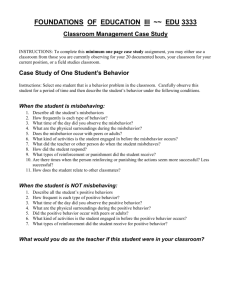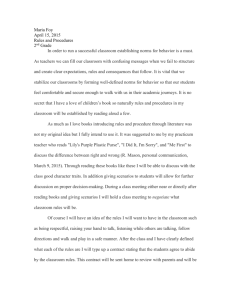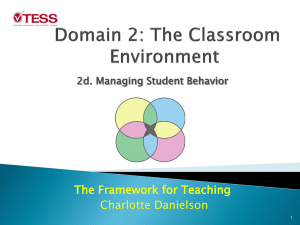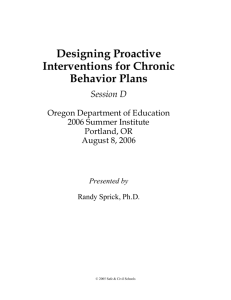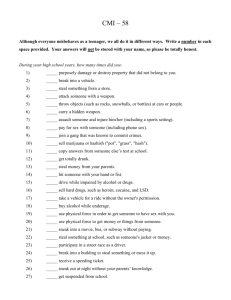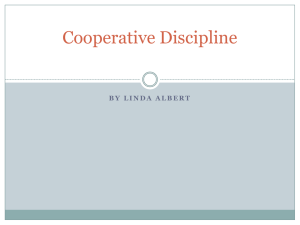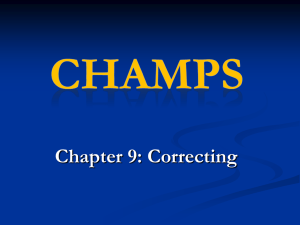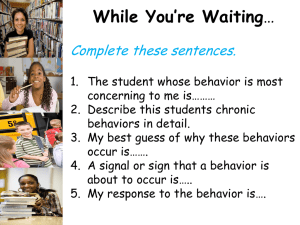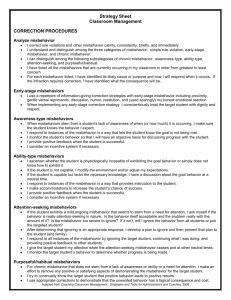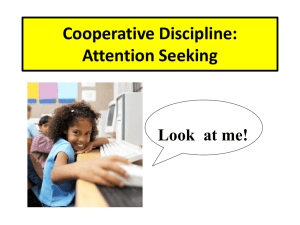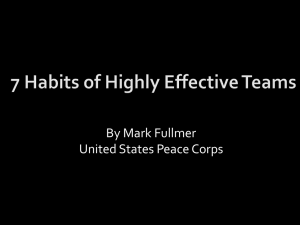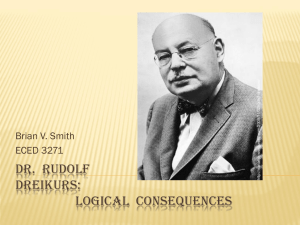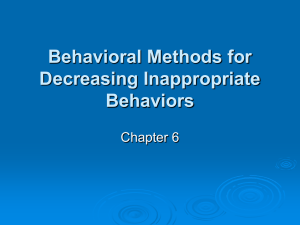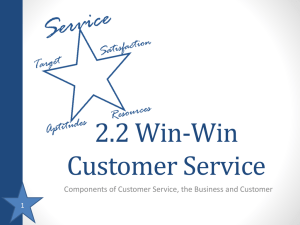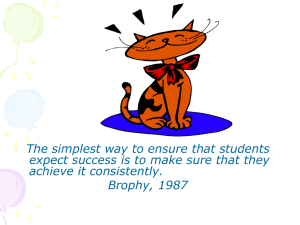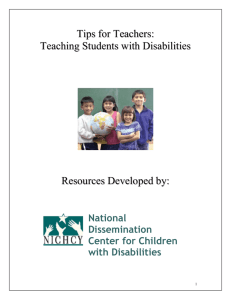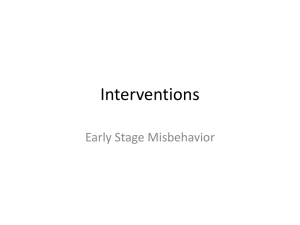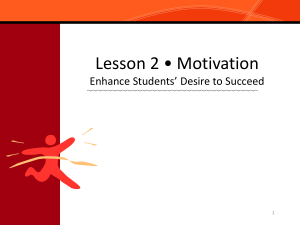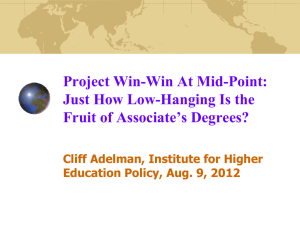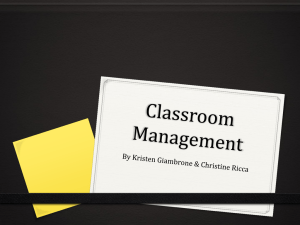Spencer Kangan`s Win-Win Discipline PowerPoint
advertisement
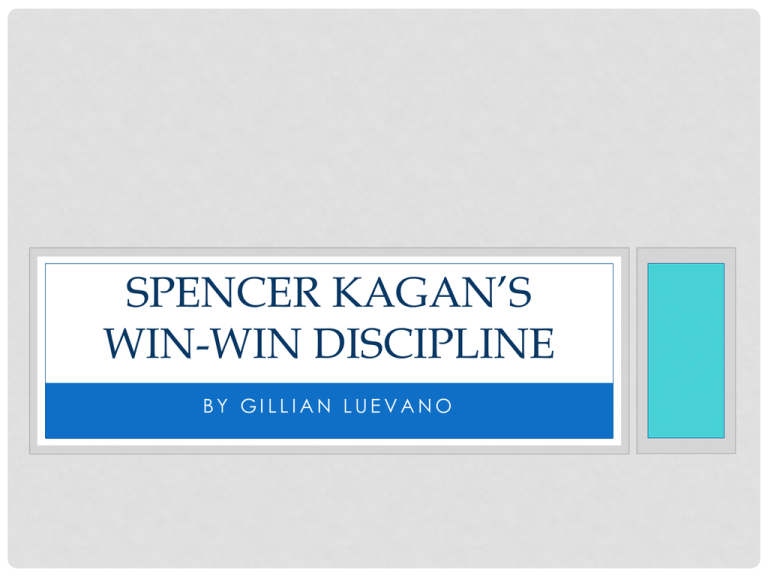
SPENCER KAGAN’S WIN-WIN DISCIPLINE BY GILLIAN LUEVANO OBJECTIVES • You will be able to collaborate on creating positive class rules. • You will be able to identify types of misbehavior. • You will be able to identify why misbehavior happens, the student’s position. • You will be able to identify structures to use to stop misbehavior from happening in the present and in the future. 3 PILLARS TO WIN-WIN DISCIPLINE • Same side: we work together to enhance the school experience. • Collaborative solutions: students and teachers cooperate in proposing workable solutions to behavior problems. • Learned responsibility: the desire to behave appropriately, which students acquire by practicing self management and skills of getting along with others. CLASS RULES • Rules are worked out between the students and the teacher. • Rules are worded simply. • Rules are limited to 5 or less, some teachers prefer to use only one rule. • Rules are posted for easy access. CLASS RULES • Activity “think, pair, share” • Take a couple minutes to think about possible rules for your classroom. • Pair up with a classmate and discuss the rules you came up with and decide which rules you would use. • Share the rules you decided on with the class. THE ABCDS OF MISBEHAVIOR • Paying attention to the types of misbehavior helps students and teachers come up with solutions. • Aggression: hostility between students which can be verbal or physical. • Breaking Rules: students break rules when they are unable to meet their own needs. • Confrontation: power struggles can happen between students or the student and teacher. • Disengagement: students may disengage from the lesson for a variety of reasons. STUDENT POSITIONS • Students have physical and mental needs. • When needs are not met, the students might misbehave. • Teachers must understand the student’s position, acknowledge it, accept and validate it, and work with the student to come up with a solution for it. STUDENT POSITIONS • • • • • • • Attention seeking Avoiding failure and/or embarrassment Angry Control Seeking Engergetic Bored Uninformed STRUCTURES • Structures are procedures to manage misbehavior. • Structures are contingent on the type of misbehavior and the student’s position (attention to needs). • Structures have three stages: the moment of misbehavior, the follow-up, and long-term. HOW TO USE WIN-WIN • Have a rich curriculum. • Identify the student’s position. • Communicate acceptance while refusing to accept disruptive behavior. • Apply an appropriate structure, matched to the student’s behavior to help the student meet their needs. STRUCTURE CHART Structure Chart: What should teachers do? Student Position Long-term needs and goals Moment of disruption Follow-up Long-term strategies Attention-seeking Self-validation -Physical proximity and hand or facial signals -Provide additional attention and affirmation Meet with disruptive students and discuss the need for attention and how to obtain it Strengthen their self-concept and acquire skills for self-validation Avoiding failure and Embarrassment Self-confidence -Encourage students to try to complete the task -Assign students partners -Reorganize and present information in small pieces -Ask students: how might responsible people deal with failure? -Provide peer support. -Review how mistakes are part of the learning process. -Use more “team, pair, solo” activities. Angry Self-control -Allow for cool-down time. -Come back to the problem later. -Teach responsible ways to deal with anger. -Practice skills of self-control. -Teach resolving conflicts in a positive manner. Control-seeking Self-determination -Acknowledge the student’s power. -Use language of choice (You may either… or…) -Provide options of how or when work can be done. -Schedule a conference to discuss the situation. -Ask the class why students often struggle with the teacher. -Consider how to avoid struggles. -Involve students in decision making. -Ask for help in establishing class agreements about showing respect for the teacher and fellow students. Energetic Self-direction -Take a class break that allows energy to dissipate. -Provide time for relaxation -Remove distracting elements -Channel energy productively. Teach a variety of calming strategies and provide follow-up activities that allow students to work off energy in a positive way. -Manage energy levels during instruction. Bored Self-motivation -Restructure the learning task -Involve students more in the activity -Inject short activities that energize the students -Talk privately with the students -Assign the student as a caretaker, helper, etc. -Provide a rich, relevant, and developmentally appropriate curriculum that actively involves students in the learning process, emphasizes cooperative learning, and calls on students to use multiple intelligences. Uninformed Self-inform -Gently ask students what they are supposed to know -Reteach if necessary -Let them work with a partner if they need support -Be more careful when giving directions, modeling desired responses, and providing practice in responsible behavior -Be encouraging and focus on the student’s strengths. ACTIVITY: TEAM, PAIR, SOLO • As a team decide what the student’s position is and what structure should be used at the moment of disruption. • As a pair decide what a good follow-up structure is and share it with the class. • Alone choose the best long-term strategy and share it with the class. SCENARIO “During a cooperative group situation, Samuel, a new boy in class, disrupts the class by standing up and calling over to Duwahn in another group. Samuel may or may not know that this behavior is inappropriate, but his action violates one of the class rules that class members have agreed upon. What should be done?” SCENARIO “Sara is a pleasant girl who participates in class activities and does most, though not all, of her assigned work. She cannot seem to refrain from talking to classmates, however. Her teacher has to speak to her repeatedly during lessons, to the point that he often becomes exasperated and loses his temper. What should be done?” FOR MORE INFORMATION • Read: Win-Win Discipline by Spencer Kagan • Explore: www.kaganonline.com • Attend: Win-Win Discipline Workshop in Maryville, MO July 30th-August 3rd
